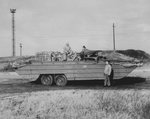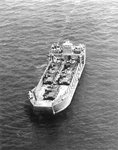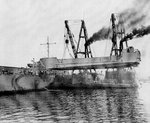syscom3
Pacific Historian
Post your information for all the boats and vehicals used in WW2 for amphib warfare. For those of you that still think the Germans could have have invaded England, these are the craft they didnt have to be able to pull the invasion off.
I will start with his one. Perhaps one of the most important 'craft" developed in WW2. It revolutionized logistics as it could take the material directly from a larger ship inland. This advoided the time consuming and inefficent offloading on a beach and then reloading on terrestial trucks.
The DUKW (popularly pronounced DUCK) is a six-wheel-drive amphibious truck that was originally designed inside General Motors Corporation during World War II for transporting goods and troops over land and water and for use approaching and crossing beaches in amphibious attacks.
Its designation as a DUKW is not a military pun, the name comes from the terminology used for military vehicles in World War II; the D indicates a vehicle designed in 1942, the U meant "utility (amphibious)", the K indicated all-wheel drive and the W indicated two powered rear axles. The DUKW was built around a conventional six-wheel-drive military truck called the CCKW, with the addition of a watertight hull and a propeller. The vehicle was built by the GMC division of General Motors (called Yellow Truck and Coach at the beginning of the war). It was powered by a GMC Straight-6 engine of 270 in³ (4.4 L). The DUKW weighed 7.5 tons and operated at 6.4 mph (10 km/h) on water and 50 mph (80 km/h) on land. It was 31 feet (9.3 m) long, 8.25 feet (2.4 m) wide, and 8.8 feet (2.6 m) high with the folding-canvas top up. More than 21,000 were manufactured. Contrary to its outward appearance it was not an armored vehicle, being plated with sheet steel between 1/16" and 1/8" thick to keep the weight down. A high-capacity bilge pump system kept the DUKW afloat if the thin hull was breached by holes up to a couple inches in diameter.
The DUKW was the first vehicle to allow the driver to vary the tire pressure from inside the cab, an accomplishment of Speir's devise. The tires could be fully inflated for hard surfaces such as roads and less inflated for softer surfaces—especially beach sand. This added to the DUKW's great versatility as an amphibious vehicle. This feature is now standard on many military vehicles.
The DUKW was used in landings in the Pacific, in North Africa, and on the D-Day beaches of Normandy. With the enemy holding all available ports, DUKWs carried 18 million tons of supplies ashore in the 90 days following the landing
The DUKW's ability to board and debark without assistance via way of an LST's ramp enabled the ship to anchor offshore, thereby reducing reef and beach congestion and lessened the danger of enemy fire on ship and personnel. Furthermore, the hybrid's ability to cross coral reefs and sandy beaches and then proceed inland to wherever supplies were needed saved what would otherwise have been countless man-hours of handling supplies. The DUKW's versatility forestalled the necessity to bring heavy transport vehicles ashore during early stages of invasions, further reducing island and beach congestion.
Rated capacity – 5000 lbs.
270 cid 6–cylinder GMC motor.
Weight 14,800–Lbs.
Rated at, governed, 6.4 mph water and 50 mph land.
21,000+ manufactured–WWII only.
$10,800.00 cost.
Marines–two man crew, driver and assistant driver.
Tire inflation/deflation by driver from inside cab.
First operational use in Pacific at Noumea, 1943, in Europe at Sicily, 1943.
D-Day info:
D Day Tanks and countdown to 60th anniversary of D-Day from the Tank Museum Bovington
USMC info:
MARINE DUKWS IN WWII
I will start with his one. Perhaps one of the most important 'craft" developed in WW2. It revolutionized logistics as it could take the material directly from a larger ship inland. This advoided the time consuming and inefficent offloading on a beach and then reloading on terrestial trucks.
The DUKW (popularly pronounced DUCK) is a six-wheel-drive amphibious truck that was originally designed inside General Motors Corporation during World War II for transporting goods and troops over land and water and for use approaching and crossing beaches in amphibious attacks.
Its designation as a DUKW is not a military pun, the name comes from the terminology used for military vehicles in World War II; the D indicates a vehicle designed in 1942, the U meant "utility (amphibious)", the K indicated all-wheel drive and the W indicated two powered rear axles. The DUKW was built around a conventional six-wheel-drive military truck called the CCKW, with the addition of a watertight hull and a propeller. The vehicle was built by the GMC division of General Motors (called Yellow Truck and Coach at the beginning of the war). It was powered by a GMC Straight-6 engine of 270 in³ (4.4 L). The DUKW weighed 7.5 tons and operated at 6.4 mph (10 km/h) on water and 50 mph (80 km/h) on land. It was 31 feet (9.3 m) long, 8.25 feet (2.4 m) wide, and 8.8 feet (2.6 m) high with the folding-canvas top up. More than 21,000 were manufactured. Contrary to its outward appearance it was not an armored vehicle, being plated with sheet steel between 1/16" and 1/8" thick to keep the weight down. A high-capacity bilge pump system kept the DUKW afloat if the thin hull was breached by holes up to a couple inches in diameter.
The DUKW was the first vehicle to allow the driver to vary the tire pressure from inside the cab, an accomplishment of Speir's devise. The tires could be fully inflated for hard surfaces such as roads and less inflated for softer surfaces—especially beach sand. This added to the DUKW's great versatility as an amphibious vehicle. This feature is now standard on many military vehicles.
The DUKW was used in landings in the Pacific, in North Africa, and on the D-Day beaches of Normandy. With the enemy holding all available ports, DUKWs carried 18 million tons of supplies ashore in the 90 days following the landing
The DUKW's ability to board and debark without assistance via way of an LST's ramp enabled the ship to anchor offshore, thereby reducing reef and beach congestion and lessened the danger of enemy fire on ship and personnel. Furthermore, the hybrid's ability to cross coral reefs and sandy beaches and then proceed inland to wherever supplies were needed saved what would otherwise have been countless man-hours of handling supplies. The DUKW's versatility forestalled the necessity to bring heavy transport vehicles ashore during early stages of invasions, further reducing island and beach congestion.
Rated capacity – 5000 lbs.
270 cid 6–cylinder GMC motor.
Weight 14,800–Lbs.
Rated at, governed, 6.4 mph water and 50 mph land.
21,000+ manufactured–WWII only.
$10,800.00 cost.
Marines–two man crew, driver and assistant driver.
Tire inflation/deflation by driver from inside cab.
First operational use in Pacific at Noumea, 1943, in Europe at Sicily, 1943.
D-Day info:
D Day Tanks and countdown to 60th anniversary of D-Day from the Tank Museum Bovington
USMC info:
MARINE DUKWS IN WWII




